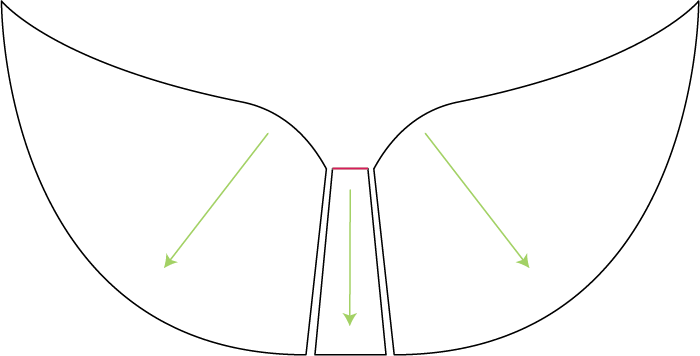Faroese Shawl Design
Faroese shawls are my all-time favorite. They look like wings and due to their shape it’s easy to tie them behind your back, providing you with extra warmth during cold winter days. Traditionally they were worked in thicker yarns and often they were lined making them a piece of everyday clothing.
The figure below shows a sketch of the shape of a Faroese shawl design.

A very good book on Faroese shawls is Føroysk Bindingarmynstur / Faroese Knitting Patterns, published by Schoolhouse Press.
Construction Methods For Faroese Shawls
Faroese shawls can be constructed in three different ways:
- By working them top-down and working increases the traditional Faroese way,
- By working them bottom-up and working decreases the traditional Faroese way, and
- By working them top-down and working raglan increases.
Traditional Faroese Shawl Construction
Traditional Faroese Shawls are constructed by working increases (if you decide to work top-down) or decreases (if you decide to work bottom-up) at certain points of the shawl additionally to the decreases similar to those worked in triangle shaped shawls. The amount and positions of the in-/decreases depend on of the exact shape of the shawl you want to create, but generally there are two to four of these rows present.
An example pattern for a traditional shaped Faroese shawl is the Redwing knitting pattern.
Pattern Template: Traditional Faroese Shawl
For working a traditional Faroese Shawl (top down) follow the recipe for a triangle shawl with center panels first. Choose a center pattern that is small at the neck (around 10 stitches).
At the same time, work the following additional increases:
- At the center panel, work 3 increases every 16 rows (stop increasing when your center panel is abut 40 sts wide).
- At the side panels, work additional increases as follows:
- At row 41, increase every 3rd stitch by working YO, k1 instead of k1.
- At row 81, increase every 7th stitch by working YO, k1 instead of k1.
- At row 120, increase every 9th stitch by working YO, k1 instead of k1.
This shapes a Faroese shape in the traditional way.
Another possibility is to construct Faroese shawls using raglan increases. An example pattern using this construction method is Raglan Faroese.


I tried clicking on the links, the redwing shawl and the raglan faroese links. Neither one opened up and it took me to an error page. Are these still available?
Thanks for notifying me, I’ll check!
Looks like these links are still down. Any way to resolve this?
I also encountered a 404 error page when I clicked on those links
Pingback: Shawl Shapes Overview 2019: Julia's New Shawl Design Cheatsheet
Pingback: Shawl Design for Everybody - Your Free Shawl Design Online Course
Pingback: Discovering A New Method of Knitting Faroese Shawls ... By Accident - knitting.today
Pingback: Shawl Design for Everybody - Your Free Shawl Design Online Course